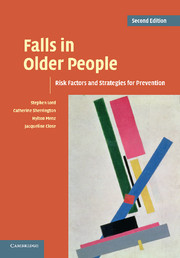Book contents
- Frontmatter
- Contents
- Preface
- Acknowledgements
- Part I Epidemiology and risk factors for falls
- Part II Strategies for prevention
- 10 Exercise interventions to prevent falls
- 11 Exercise interventions to improve physical functioning
- 12 Medical management of older people at risk of falls
- 13 Assistive devices and falls prevention
- 14 Modifying the environment to prevent falls
- 15 Prevention of falls in hospitals and residential aged care facilities
- 16 A physiological profile approach to falls risk assessment and prevention
- 17 Research into practice
- Part III Research issues in falls prevention
- Index
- References
14 - Modifying the environment to prevent falls
Published online by Cambridge University Press: 03 May 2010
- Frontmatter
- Contents
- Preface
- Acknowledgements
- Part I Epidemiology and risk factors for falls
- Part II Strategies for prevention
- 10 Exercise interventions to prevent falls
- 11 Exercise interventions to improve physical functioning
- 12 Medical management of older people at risk of falls
- 13 Assistive devices and falls prevention
- 14 Modifying the environment to prevent falls
- 15 Prevention of falls in hospitals and residential aged care facilities
- 16 A physiological profile approach to falls risk assessment and prevention
- 17 Research into practice
- Part III Research issues in falls prevention
- Index
- References
Summary
This chapter outlines commonly suggested environmental modification strategies, and reviews the literature evaluating falls prevention programmes that have involved environmental modification as an individual intervention or as part of multi-faceted programmes. It discusses potential barriers to home modification, issues related to hazard removal and design strategies for minimizing older people's risk of falling in public places. Approaches for addressing environmental risk factors within institutions are discussed in Chapter 15.
Environmental modification strategies
Table 8.1 in Chapter 8 presents a list of environmental falls risk factors that have been suggested in the literature. These posited risk factors are replicated in Table14.1 along with potential solutions.
Environmental modification as an individual intervention
Environmental modification is seen by many as an attractive falls prevention strategy. The homes of most older people have many environmental hazards and the majority of these are amenable to modification. Correction and/or removal of potential hazards is a one-off intervention that can be carried out relatively cheaply. Indeed, cost-effectiveness modelling has predicted that spending AUD$244 per person on a programme involving home assessment by an occupational therapist and subsequent modifications, would save $92 per person and $916 per fall prevented, over a ten year period. However, this study assumes that such a programme could prevent 25% of falls. Reductions of this magnitude have yet to be demonstrated in controlled studies.
Early investigations indicated that home modification might be an effective falls prevention strategy for the general population of older people.
- Type
- Chapter
- Information
- Falls in Older PeopleRisk Factors and Strategies for Prevention, pp. 300 - 310Publisher: Cambridge University PressPrint publication year: 2007
References
- 1
- Cited by



